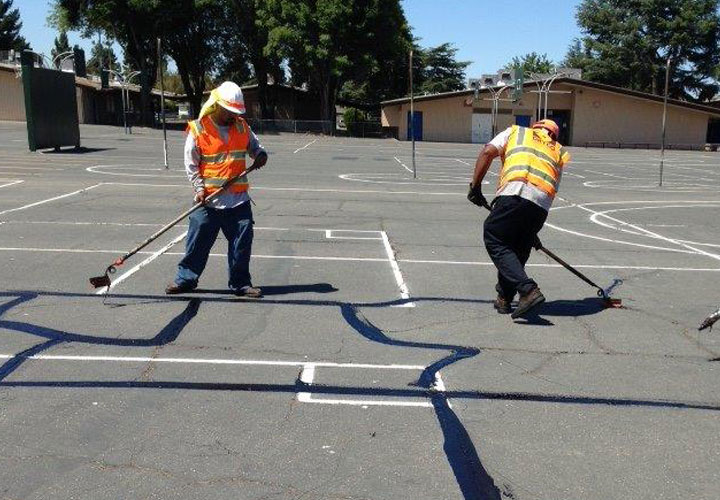Improve Durability with Cold Mix Asphalt: Expert Sealing Solutions
Wiki Article
Cold Mix Asphalt Vs. Hot Mix Asphalt: Which Is Right for You?

Structure Differences
Cold mix and hot mix asphalts vary considerably in their make-up, with unique characteristics that affect their performance and applications. Cold mix asphalt is produced by emulsifying the asphalt binder with water and an emulsifying agent before mixing it with aggregate. This approach enables the asphalt to be practical at reduced temperatures, making it perfect for momentary fixings and for use in cooler climate condition. Hot mix asphalt, on the other hand, is made at heats, generally in between 300-350 ° F, which assists to accomplish far better compaction and an extra sturdy end product. The warm mix asphalt manufacturing procedure entails heating up the accumulation and asphalt binder independently prior to integrating them at the asphalt plant.
Additionally, cool mix asphalt has a tendency to be much less thick and more adaptable than hot mix asphalt. This versatility makes it better matched for locations with greater degrees of motion, such as driveways or roadways with hefty website traffic. In contrast, hot mix asphalt is known for its high longevity and resistance to rutting and breaking, making it a recommended option for freeways and high-traffic roads where long life is critical.
Setup Refine Variations
The procedure of setting up cool mix and warm mix asphalt displays significant differences in their requirements and treatments. In comparison, hot mix asphalt necessitates a much more intricate setup process. Due to the heating requirements, hot mix asphalt installations are typically lugged out by experts with specific devices, making sure a more structurally audio and long-term outcome.Durability and Long Life Aspects
When taking into consideration asphalt alternatives, resilience and long life are crucial aspects to evaluate for enduring pavement performance. Warm mix asphalt (HMA) is known for its remarkable durability and longevity.
In regards to longevity, HMA normally outshines CMA because of its remarkable stamina and resistance buildings. HMA sidewalks have a longer service life, calling for less frequent fixings and upkeep, which can equate to set you back savings in the future. In addition, HMA pavements are more easily personalized to meet particular task demands, further enhancing their toughness.
Expense Factors To Consider
Thinking about the monetary implications is an essential element when assessing the option in between hot mix asphalt (HMA) and cold mix asphalt (CMA) for sidewalk projects. While the initial cost of hot mix asphalt is generally greater than that of cold mix asphalt, HMA typically provides a more cost-efficient service in the long run due to its remarkable durability and durability.In addition to product prices, it's vital to take into consideration the expenditures connected with installation and maintenance when comparing HMA and CMA. Inevitably, the choice in between HMA and CMA need to take into account not simply the initial price but likewise the lasting monetary implications to figure out the most economical option for the certain pavement project.
Environmental Impact Contrast
Contrast of the ecological effects in between warm mix asphalt (HMA) and cool mix asphalt (CMA) reveals distinctive distinctions in sustainability methods. HMA manufacturing needs high temperature levels, leading to increased energy usage and greenhouse gas emissions.Furthermore, the usage of CMA typically involves recycling existing asphalt pavement, promoting resource preservation and reducing the quantity of waste sent to landfills. This reusing aspect even more enhances the sustainability of CMA cold mix asphalt contrasted to HMA. In general, when considering the ecological impact, CMA becomes a much more ecologically lasting selection due to its reduced energy requirements, decreased exhausts, and the capacity for reusing existing materials. By choosing CMA over HMA, road building and construction tasks can contribute positively to environmental conservation initiatives.
Conclusion
To conclude, the selection between cold mix asphalt (CMA) and hot mix asphalt (HMA) relies on numerous factors such as make-up, setup procedure, resilience, long life, expense, and environmental influence. asphalt patch repair. While CMA uses a quick and economical solution for small fixings, HMA makes sure exceptional durability and long life for rush hour locations. Think about these elements meticulously to identify which kind of asphalt is the right selection for your paving needs
Taking into consideration the financial effects is an important aspect when assessing the option between warm mix asphalt (HMA) and chilly mix asphalt (CMA) for pavement tasks. While the preliminary cost of warm mix asphalt is usually greater than that of cool mix asphalt, HMA often supplies a much more economical solution in the lengthy run due to its remarkable longevity and durability. angle parking.Comparison of the ecological impacts in between warm mix asphalt (HMA) and cold mix asphalt (CMA) discloses unique differences in sustainability methods.In conclusion, the selection between chilly mix asphalt (CMA) and warm mix asphalt (HMA) depends on different elements such as composition, installation procedure, sturdiness, durability, price, and environmental impact
Report this wiki page